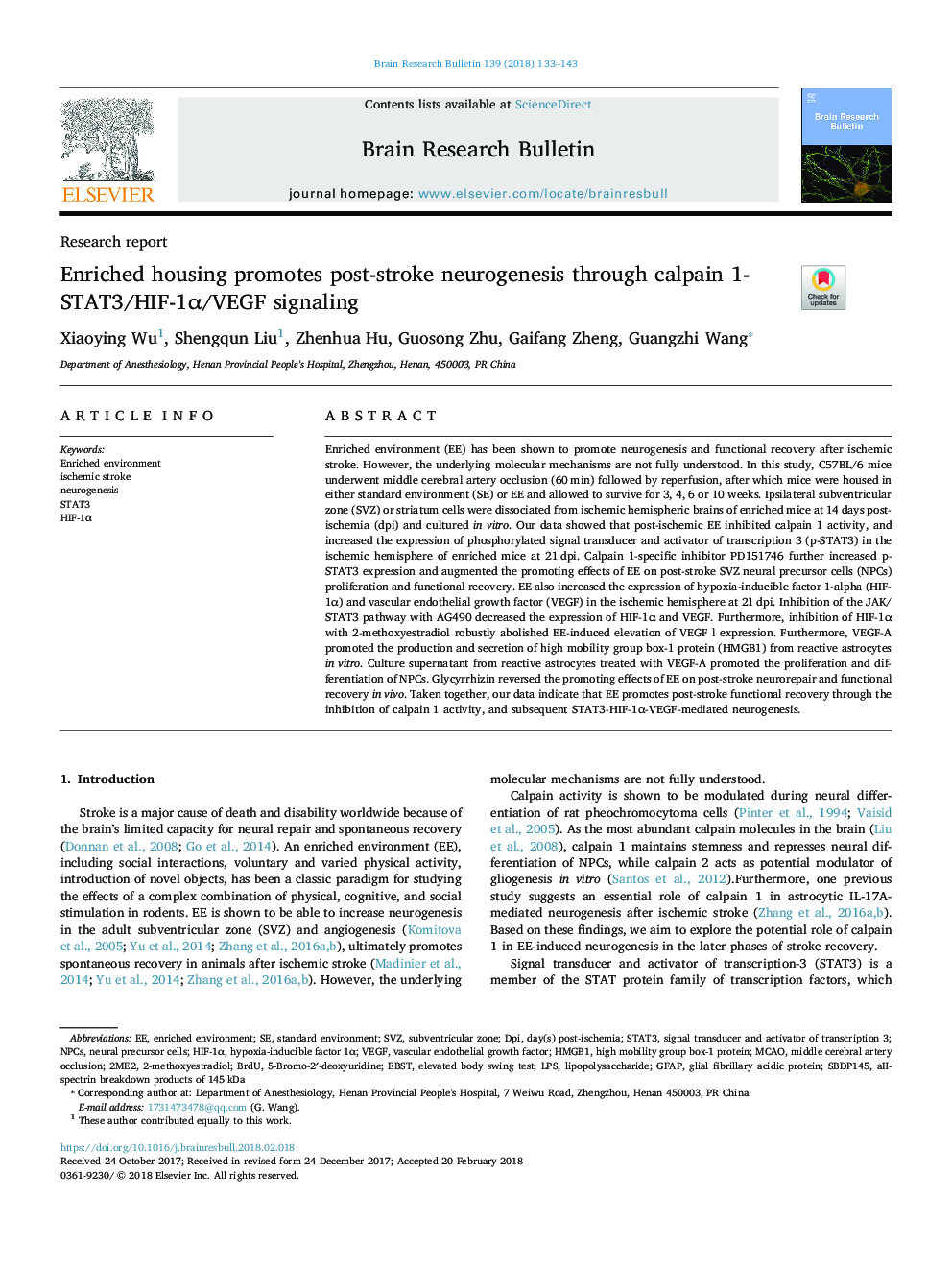| کد مقاله | کد نشریه | سال انتشار | مقاله انگلیسی | نسخه تمام متن |
|---|---|---|---|---|
| 8838921 | 1613218 | 2018 | 11 صفحه PDF | دانلود رایگان |
عنوان انگلیسی مقاله ISI
Enriched housing promotes post-stroke neurogenesis through calpain 1-STAT3/HIF-1α/VEGF signaling
دانلود مقاله + سفارش ترجمه
دانلود مقاله ISI انگلیسی
رایگان برای ایرانیان
کلمات کلیدی
MCAOEBST2me22-MethoxyestradiolSVZHMGB1HIF-1αDPIGFAPSTAT3LPS5-bromo-2′-deoxyuridine - 5-bromo-2'-deoxyuridineNPCs - NPC هاmiddle cerebral artery occlusion - انسداد شریان (سرخرگ) مغزی میانیBrdU - بروموداکسی اوریدینElevated body swing test - تست نوسان بدن افزایش یافته استNeural precursor cells - سلول های پیشگیر عصبیIschemic stroke - سکته مغزی ایسکمیکhypoxia-inducible factor 1α - عامل القایی هیپوکسی 1αVascular endothelial growth factor - فاکتور رشد اندوتلیال عروقیVascular Endothelial Growth Factor (VEGF) - فاکتور رشد اندوتلیال عروقی (VEGF)lipopolysaccharide - لیپوپلی ساکاریدsignal transducer and activator of transcription 3 - مبدل سیگنال و فعال کننده رونویسی 3standard environment - محیط استانداردEnriched environment - محیط غنی شدهsubventricular zone - منطقه فرعیNeurogenesis - نوروژنزGlial fibrillary acidic protein - پروتئین اسیدی فیبریلاسیون گلایالhigh mobility group box-1 protein - پروتئین جعبه 1 پروتئین گروه تحرک بالا
موضوعات مرتبط
علوم زیستی و بیوفناوری
علم عصب شناسی
علوم اعصاب سلولی و مولکولی
پیش نمایش صفحه اول مقاله

چکیده انگلیسی
Enriched environment (EE) has been shown to promote neurogenesis and functional recovery after ischemic stroke. However, the underlying molecular mechanisms are not fully understood. In this study, C57BL/6 mice underwent middle cerebral artery occlusion (60â¯min) followed by reperfusion, after which mice were housed in either standard environment (SE) or EE and allowed to survive for 3, 4, 6 or 10 weeks. Ipsilateral subventricular zone (SVZ) or striatum cells were dissociated from ischemic hemispheric brains of enriched mice at 14â¯days post-ischemia (dpi) and cultured in vitro. Our data showed that post-ischemic EE inhibited calpain 1 activity, and increased the expression of phosphorylated signal transducer and activator of transcription 3 (p-STAT3) in the ischemic hemisphere of enriched mice at 21â¯dpi. Calpain 1-specific inhibitor PD151746 further increased p-STAT3 expression and augmented the promoting effects of EE on post-stroke SVZ neural precursor cells (NPCs) proliferation and functional recovery. EE also increased the expression of hypoxia-inducible factor 1-alpha (HIF-1α) and vascular endothelial growth factor (VEGF) in the ischemic hemisphere at 21â¯dpi. Inhibition of the JAK/STAT3 pathway with AG490 decreased the expression of HIF-1α and VEGF. Furthermore, inhibition of HIF-1α with 2-methoxyestradiol robustly abolished EE-induced elevation of VEGF l expression. Furthermore, VEGF-A promoted the production and secretion of high mobility group box-1 protein (HMGB1) from reactive astrocytes in vitro. Culture supernatant from reactive astrocytes treated with VEGF-A promoted the proliferation and differentiation of NPCs. Glycyrrhizin reversed the promoting effects of EE on post-stroke neurorepair and functional recovery in vivo. Taken together, our data indicate that EE promotes post-stroke functional recovery through the inhibition of calpain 1 activity, and subsequent STAT3-HIF-1α-VEGF-mediated neurogenesis.
ناشر
Database: Elsevier - ScienceDirect (ساینس دایرکت)
Journal: Brain Research Bulletin - Volume 139, May 2018, Pages 133-143
Journal: Brain Research Bulletin - Volume 139, May 2018, Pages 133-143
نویسندگان
Xiaoying Wu, Shengqun Liu, Zhenhua Hu, Guosong Zhu, Gaifang Zheng, Guangzhi Wang,